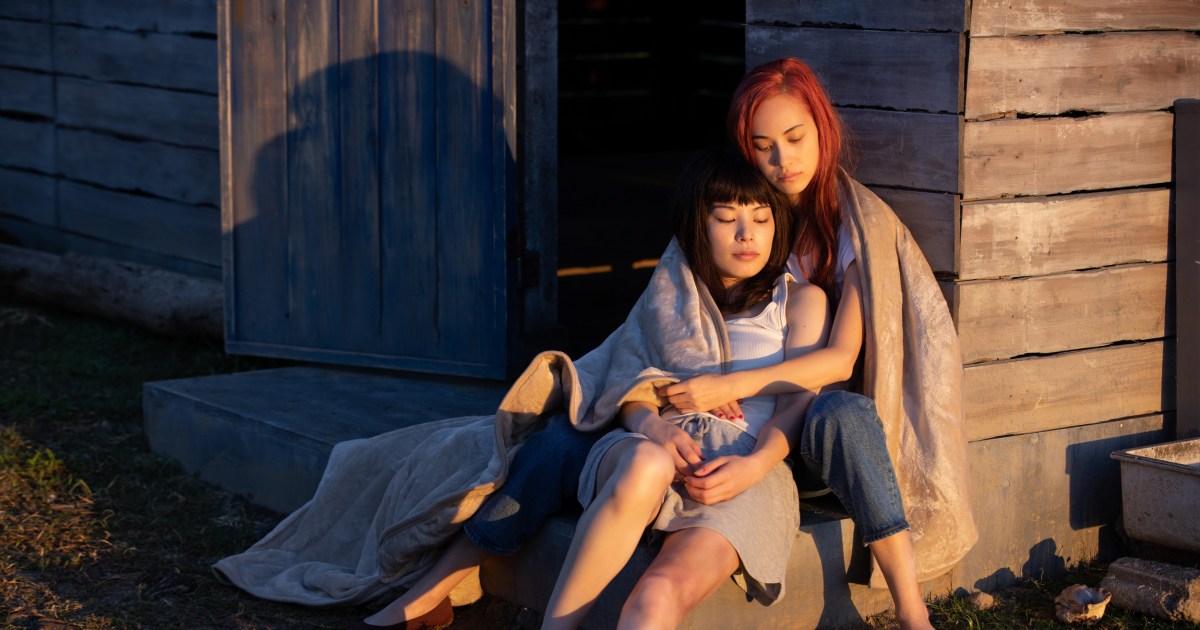
How far would you go to protect your one true love? That is the question at the heart of Japanese director Ryuichi Hiroki’s new psychological thriller, “Ride or Die,” which premiered on Netflix on Thursday.
Based on Ching Nakamura’s popular graphic novel series, or manga, “Gunjō,” the film tells the stirring story of Rei Nagasawa (Kiko Mizuhara) and Nanae Shinoda (Honami Sato), two Japanese women who struggle with their conflicting feelings for each other.
When Rei, a lesbian in her 20s, receives an unexpected call from Nanae, the girl she was in love with during high school, she drops everything to go see her for the first time in a decade. But when she discovers that Nanae is trapped in a physically abusive marriage, Rei decides to take matters into her own hands. Without giving her actions a second thought, Rei seduces and kills Nanae’s husband in an attempt to protect her and to prove her love, which sets off a meandering series of events that bring the two women closer than ever before.
Since “Gunjō” started to circulate in 2007, numerous filmmakers have attempted to adapt the manga for the big screen, but most of them have struggled to capture the intense visual language of Nakamura’s original work, which spans 35 chapters and includes some very graphic depictions of sex and violence. The new adaptation eventually came to fruition under the direction of Hiroki, who is known for his intense and painful romance films, and was written by Nami Kikkawa.
Sato, 31, said she is a “huge fan of Ching Nakamura’s work” and was familiar with “Gunjō” before being offered the role of Nanae.
“When they offered me this project, I felt like it was a dream,” Sato told NBC News in a joint interview with Kiko Mizuhara, using an interpreter. “I did have apprehensions as to whether or not we could reconstruct what was in the manga as a film, [because] a manga is a manga and films are films. They’re different mediums. But reading the script, I felt that we were able to make [and honor] ‘Gunjō,’ and that was something very important to me.”
“Rei and Nanae’s relationship and dynamic actually build up and grow little-by-little, and you see that reflected on the screen.”
Honami Sato
Mizuhara, by contrast, was not as familiar with the original source material. But she said when she read it for the first time, she immediately knew that she wanted to bring the same “energy, strength and intensity” to her deeply nuanced portrayal of Rei, even if she knew that it would be “a daily struggle” to go through the same emotions that Rei experiences in the film.
“The film, I think, stands on its own from the manga, but I also wanted to make sure that those things were reflected,” Mizuhara, 30, said.
Filmed last summer in various locations across Japan during the early months of the Covid-19 pandemic, “Ride or Die” breaks a number of conventions in the studio-dominated Japanese entertainment industry. In the pre-production phase, Kikkawa got permission to make a number of changes that deviate from the original manga series, including turning this iteration into a road movie, giving the protagonists proper names, and changing the Japanese title to “Kanojo” (which means “she” or “girlfriend”). Hiroki also decided to shoot the film chronologically — another rarity in Japanese cinema — which allowed Mizuhara and Sato to evolve with their respective characters.
“The character I play, Nanae, has no family, has no friends, and her husband is very violent towards her,” Sato explained. “She doesn’t have anybody who she can really speak her truth with, and Rei is somebody that knows her vulnerable side as well. They have a past where Rei once helped her, and she’s always been a special person for Nanae. When Nanae calls Rei at the hotel after 10 years, Rei is the one who she feels like she wants to speak with, for better or for worse. The story starts from there, but everything really started from there for [Mizuhara and I], too. For all of the scenes, I was able to be really emotionally spontaneous, and everything really came from the evolution of the scenes.”
And because the film progresses chronologically, Sato said “Rei and Nanae’s relationship and dynamic actually build up and grow little-by-little, and you see that reflected on the screen.”
Mizuhara said she and Sato were “inseparable like the characters” while filming.
“We were in a state where it was like, ‘I need you. Otherwise, I won’t be able to do this,’” she revealed. “We were truly supporting each other, and even when the cameras were not rolling, we would hold hands, and we would be next to each other. Before a take, we would embrace, and we were able to really want to be together, physically and emotionally. The experience of being part of this film was really to live the characters, and that was an amazing feeling.”
“I think I was able to do that because Honami is somebody who doesn’t build walls. She’s really, really open, and even from rehearsals, we were able to give our characters our all without building up any walls, and that was really special. I’ve never experienced anything like that,” added Mizuhara, who is best known internationally for her appearances in the special “We’re in Japan!” season of “Queer Eye.”
In order to capture the spirit of the manga series, the film features two extremely graphic scenes: the first being Rei’s bloody killing of Nanae’s husband, and the second a climactic eight-minute sex scene between Rei and Nanae. In an interview with Netflix that was provided to the media, Hiroki said, “One of the reasons this work was not adapted for film for so long was that it was difficult to cast. There are simply few accomplished actresses willing to perform nude scenes.” Given the more conservative history of Japanese cinema, “Ride or Die” is a far cry from the stereotypical LGBTQ films that have graced the big screen in the past.
To prepare for the more intimate scenes of the shoot, the production team decided to hire an intimacy coordinator, a person who works on film and television sets to choreograph sex scenes between actors. Mizuhara revealed that, after hearing from other acting friends who work on HBO productions in America, she was actually the one who suggested the addition of an intimacy coordinator — a job that, in all honesty, really intrigued her.
The intimacy coordinator “came in and interviewed everybody who had any sort of intimate scenes, asking us where we would want to be touched and things like that,” Mizuhara said. “And on the day, they would protect you and look after you, deciding who can be in the scene in terms of the crew. The fact that the scene was controlled gave us a sense of security.”
“I think up until now, and especially in Japanese filmmaking, it was kind of vague when it came to how people would behave in these scenes, because there weren’t any sort of concrete rules. People would be a little shy with discussing it as well, and I thought maybe we could do something about that,” she added. “Especially with this film, some of the really important scenes are really intimate, like my sex scene with Honami — that is the key in this film. The intimacy coordinator being part of the project gave the chance for everybody to commit to these scenes, to understand what it needs and that it needs to be protected, and to look at things the same way. I was really comfortable doing the scene, and I think that’s all reflected in the final product.”
“There is an increase in LGBTQ stories being told in Japan, but the storytellers and how they’re going to tell these stories is something that we need to be really conscious of.”
Kiko Mizuhara
While this film does highlight the significant lack of LGBTQ representation in Asian entertainment, the co-leads were both quick to note that this film is different from the other ones in the genre.
“There are different types of LGBTQ stories in film that focus on the struggles, but this film is a little different, because the shape of the love that they’re able to create in the end is their own,” Mizuhara explained. “When it comes to this film, I didn’t really think too much that it could be an LGBTQ film, because I didn’t feel like that was something that was different. I’ve dated women before, and that’s something that I was incorporating into the character.”
“Rei is somebody who knows love, and that’s something that I was more conscious of than it being an LGBTQ story, but I feel that more LGBTQ films should be made for sure,” the American Japanese actress continued. “There is an increase in LGBTQ stories being told in Japan, but the storytellers and how they’re going to tell these stories is something that we need to be really conscious of.”
Sato said she hopes the film will inspire viewers to branch out and watch more films that originate outside their home country.
“Obviously, this is going to be seen by the world,” she said. “It’s the first Netflix original film from Japan in 2021, so I hope this film serves as an impetus for audiences to get into watching more and more Japanese films.”
“Ride or Die” is now available to stream on Netflix.
Follow NBC Out on Twitter, Facebook & Instagram
Source: | This article originally belongs to Nbcnews.com









